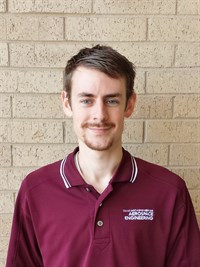 Christopher Bertagne '13, a graduate student pursuing a master’s degree in the Department of Aerospace Engineering, has been awarded a NASA Space Technical Research Fellowship (NSTRF) for 2014-2015. NASA's Space Technology Mission Directorate (STMD) offers these fellowships to graduate students who show significant potential to contribute to NASA’s goal of creating innovative new space technologies for our Nation’s science, exploration and economic future. As a Space Technology Research Fellow, Bertagne will conduct innovative research within the Texas Institute for Intelligent Materials and Structures (TiiMS), a Texas A&M Engineering Experiment Station (TEES) center organized under the Department of Aerospace Engineering at Texas A&M University. Chris received his bachelor's degree in aerospace engineering in 2013.
Christopher Bertagne '13, a graduate student pursuing a master’s degree in the Department of Aerospace Engineering, has been awarded a NASA Space Technical Research Fellowship (NSTRF) for 2014-2015. NASA's Space Technology Mission Directorate (STMD) offers these fellowships to graduate students who show significant potential to contribute to NASA’s goal of creating innovative new space technologies for our Nation’s science, exploration and economic future. As a Space Technology Research Fellow, Bertagne will conduct innovative research within the Texas Institute for Intelligent Materials and Structures (TiiMS), a Texas A&M Engineering Experiment Station (TEES) center organized under the Department of Aerospace Engineering at Texas A&M University. Chris received his bachelor's degree in aerospace engineering in 2013.
The NSTRF is a highly competitive and prestigious fellowship that requires students to submit a detailed technical proposal describing the work they will conduct under the fellowship. Bertagne's proposal was entitled "Variable Geometry Radiators Using Shape Memory Alloys." The research is based on preliminary work performed by Dr. Darren Hartl, TEES research assistant professor in the Department of Aerospace Engineering, in collaboration with researchers at NASA-Johnson. The effort builds upon an innovative morphing radiator concept that uses shape memory alloys (SMAs) to actuate in response to different heat rejection requirements over the course of a mission. The device has the potential to greatly improve performance while simultaneously decreasing mass relative to current radiator technology. According to Hartl, "this type of novel structural concept represents an ideal application of active materials technology as well as a challenging multi-physical analysis and design problem."
The fellowship, which is valued at $140,000, includes full tuition coverage, a monthly stipend, medical insurance coverage, and a PI allowance. The fellowship will begin August 2014 and lasts for two years, during which time Bertagne will benefit from the guidance of Hartl and co-advisor Dr. John Whitcomb. In addition, he will be matched with a technically relevant and community-engaged researcher, usually at a NASA center, who will serve as the student’s professional research collaborator. The research collaborator will serve as the conduit into the larger technical community corresponding to the student’s research interests.